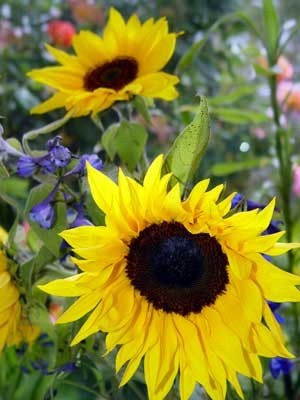 Sunflowers are perhaps the most cheerful and endearing native flower in the United States. For centuries, Native American tribes have harvested these versatile flowers for a variety of nutritional, medicinal and spiritual purposes. Today, they are grown on virtually every continent in the world. Here are some helpful hints for growing and harvesting your own.
Sunflowers are perhaps the most cheerful and endearing native flower in the United States. For centuries, Native American tribes have harvested these versatile flowers for a variety of nutritional, medicinal and spiritual purposes. Today, they are grown on virtually every continent in the world. Here are some helpful hints for growing and harvesting your own.
When purchasing seeds, keep in mind that most commercial varieties of sunflowers seeds are hybrids. This won't make a difference when consuming the seeds, but if your planning on collecting seed for future stock, look for heirloom varieties instead. Seeds should be planted at a depth of 2 inches and spaced 12 inches apart in rows spaced 24 inches apart. Tall varieties or those with extra large heads will need more space. Germination occurs quickly, usually within 7-10 days (often sooner). Most varieties reach maturity in 80-90 days.
The twenty-day period leading up to harvest is the most critical time in the development of sunflower seeds. Avoid placing water stress on plants during this time (either too much or too little) and keep soil moisture levels as consistent as possible.
Non-Insect Pests: Birds and Squirrels love sunflower seeds as much as the gardeners that grow them. Because sunflower seeds mature right around the time these critters are gearing up for fall, your sunflower crop can quickly become ransacked if not protected. Cover sunflower heads with nylon stockings, cheesecloth or paper bags to make robbing the seeds more difficult. Avoid growing your sunflowers near fences or low buildings that offer quick access to squirrels.
Insect Pests: Sunflower moths (the larvae), aphids and white flies are the primary insect pests to watch out for. Sunflowers need bees for pollination, so the use of chemical insecticides isn't recommended. Aphids and white flies can usually be kept under control by periodically spraying your sunflowers with a strong jet of water. Delaying planting until late May or early June will reduce the likelihood of sunflower moth problems.
ThriftyFun is one of the longest running frugal living communities on the Internet. These are archives of older discussions.
I grew some mammoth sunflowers and have seeds. Can I plant those seeds? How do I use the seeds for planting?
I am planning to grow sunflowers in my dryland. Please give me some advice to grow a perfect harvest.